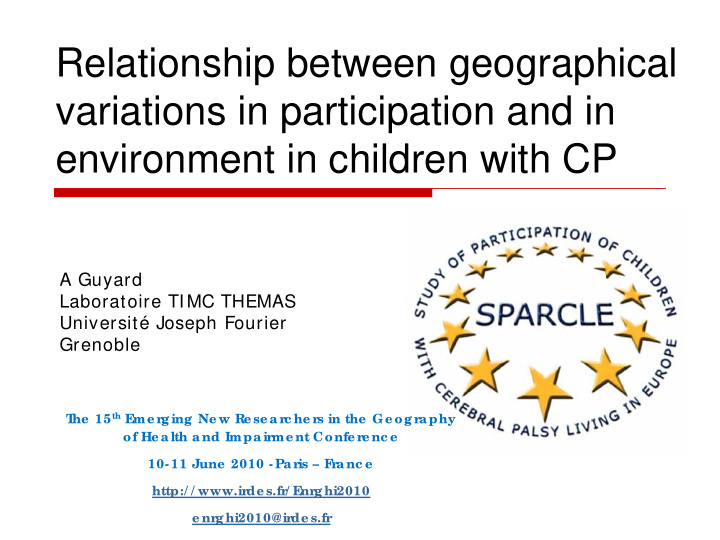



Relationship between geographical variations in participation and in environment in children with CP A Guyard Laboratoire TIMC THEMAS Université Joseph Fourier Grenoble he 15 th E T me r g ing Ne w Re se a r c he r s in the Ge og r a phy of He a lth a nd Impa ir me nt Confe r e nc e 10-11 June 2010 -Pa r is – F r a nc e http:/ / www.ir de s.fr / E nr g hi2010 e nr g hi2010@ir de s.fr
Contents o SPARCLE n Social model of disability n Project n Aims n Method o Results n Participation n Environment o Conclusion
Social Model of Disability o Disability = interaction between the individual and their environment o Participation = involvement in life situations Environmental factors Participation Impairment Personal Factors
SPARCLE Project o Study of PARticipation of Children with cerebral palsy Living in Europe o 9 centres, 8 registers, 7 countries United Kingdom (1, 3) Sweden (2) France (4, 8) Ireland (5) Denmark (6) Italy (7) Germany (9) 818 8–12-year-old CP children o o July 2004- July 2005
Aims o To evaluate variations by type and severity of impairment of children with CP 1. Involvements in life situations (participation) 2. Physical environment, transport and social support o To investigate geographical variations in both participation and environment � Recommendation to EU and local policies
Participation: Life-H 62 items based on MHAVIE ( Fougerolles and al ) o Daily life o Social roles n Meals n Responsabilities n Fitness n Relationship n Personal care n Community n Housing n School n Mobility n Leisures n Communication 1 . Eating m eals, how does your child accom plish this? With/ Without difficulty 1 7 . Does your child select the type and am ount of food he or she w ants? Yes (= > With/ Without difficulty) / No (= > Too difficult/ other)
Environment: ECEQ o European Child Environment Questionnaire: 60 items n Physical, social and attitudinal environment n At home, school, community + transport 1 . Does your child have suitably enlarged room s or extensions at hom e? Not needed / Yes / No 3 3 . Does your child receive em otional support from w ider fam ily and friends? Mostly yes / Mostly no
Contextual factors o Gender, age of the child o Type of CP o Level and type of impairment o Pain felt by children o Family structure : parents, sibling o Type of school o Qualification of parents o Parents occupations o Type of housing
Contents o SPARCLE n Social model of disability n Project n Aims n Method o Results n Participation n Environment o Conclusion
Participation in children Determinants Highly associated with n Walking ability and fine motor skills n Intellectual impairment n Communication difficulties n Epileptic seizures n Pain o Few related to visual or hearing impairment o No relation with n Socioeconomical status n CP type n Schooling
Participation in children Geographical variations Daily activities
Participation in children Geographical variations Level’s participation in Daily activities essential activities
Participation in children Geographical variations Social roles
Child’s environmental access Determinants Physical Social Attitudes environm ent support Com m unity Com m unity Classm ates Transport Teachers Fam ily & friends School Hom e Hom e Child’s im pairm ents W alking ability I ntellectual ability Com m unication Type of CP Socio-dem ographic characteristics Parental em ploym ent Gender
Child’s environmental access Geographical variations
Child’s environmental access Geographical variations
Child’s environmental access Geographical variations
Daily activities & physical environment at home Participation in daily activities Physical environment Significantly under mean Significantly above mean
Responsibility & home environment and social support Participation in responsibility Home and social support Significantly under mean Significantly above mean
Participation at school & physical and attitudinal environment at school Participation at school Physical env. and attitudes at school Significantly under mean Significantly above mean
Conclusion Participation & Environment varied by Level of impairment Region Need for modelling relationship between participation & environment More information on http: / / research.ncl.ac.uk/ sparcle/
Recommend
More recommend